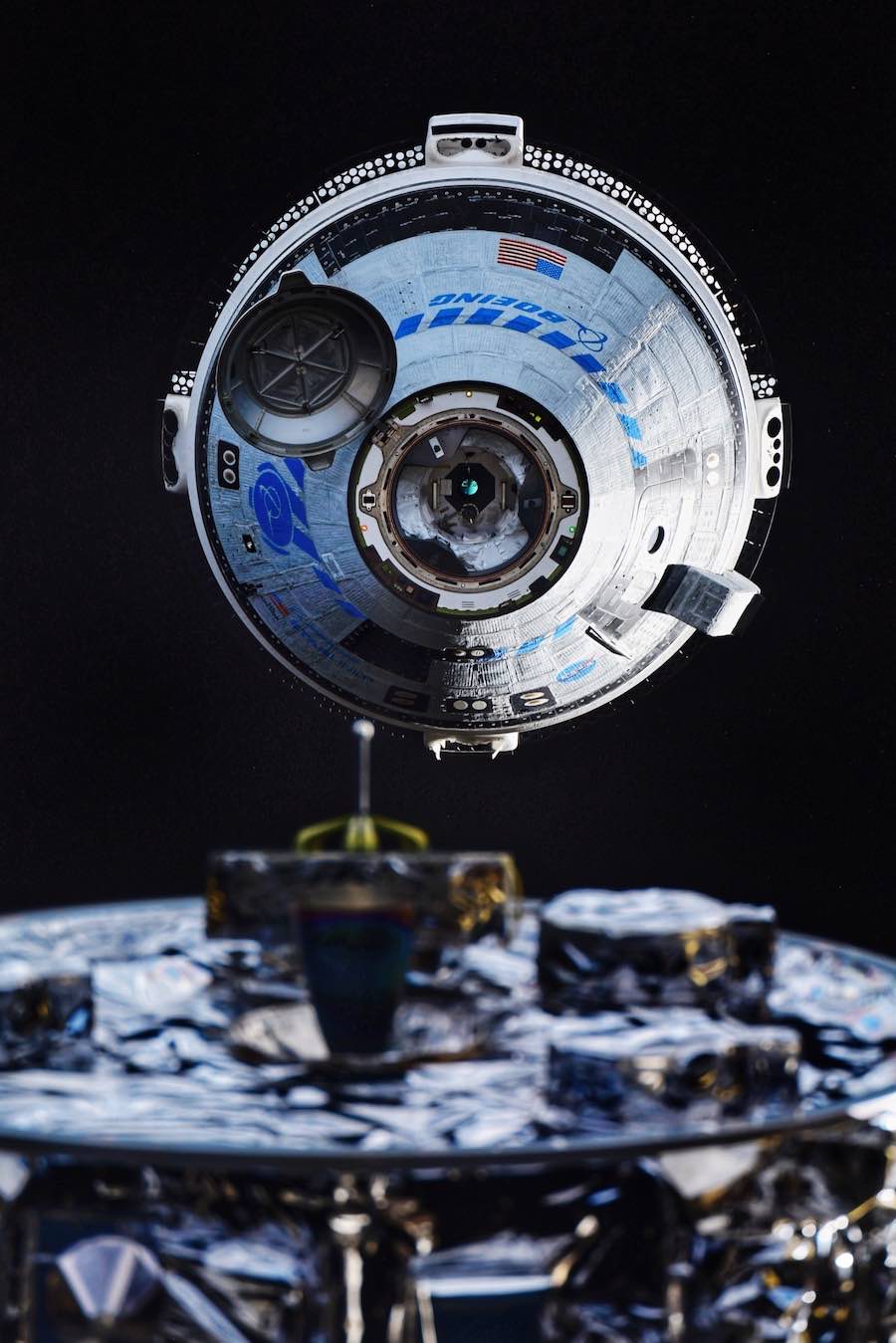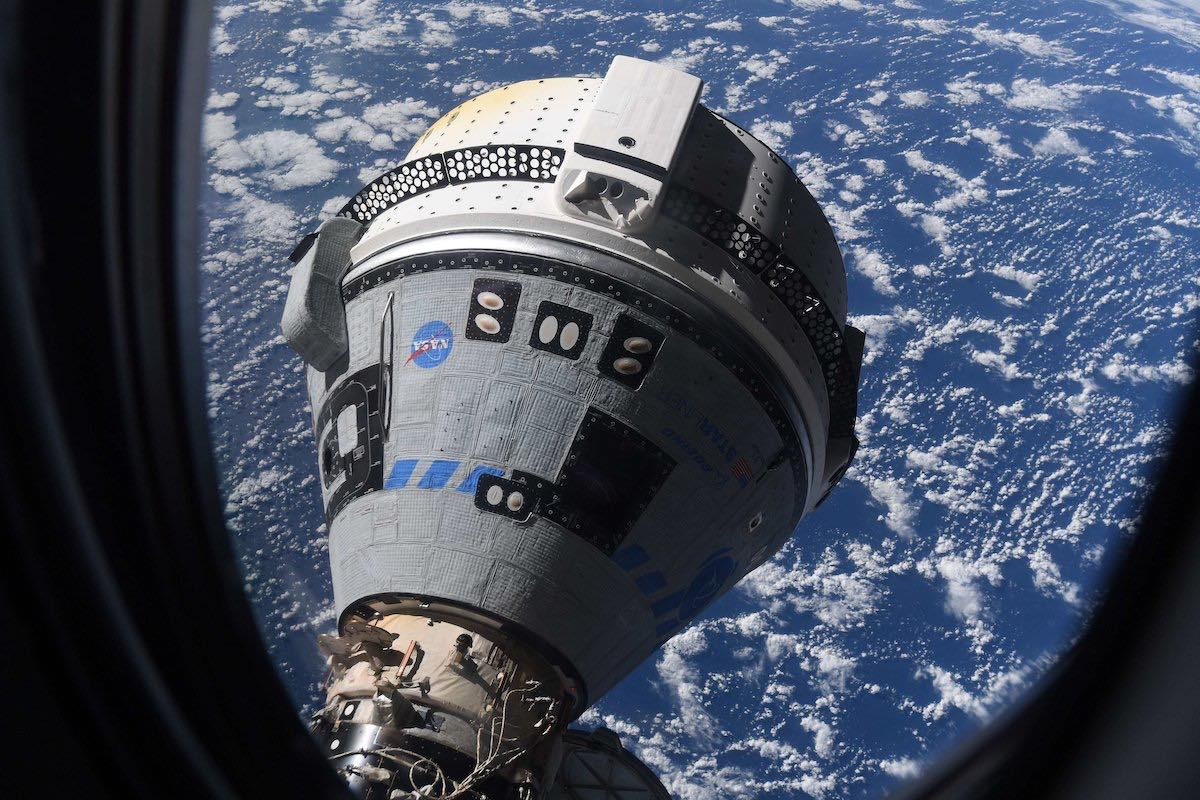Space News & Blog Articles
Boeing’s Starliner capsule completes first “nail-biting” docking at space station
 Russian cosmonaut Sergey Korsakov captured this view of the Starliner spacecraft approaching the International Space Station. Credit: Sergey Korsakov / Roscosmos
Russian cosmonaut Sergey Korsakov captured this view of the Starliner spacecraft approaching the International Space Station. Credit: Sergey Korsakov / Roscosmos
Boeing’s Starliner crew capsule finally reached the International Space Station Friday night with a “nail-biting” rendezvous and docking, overcoming several technical glitches to accomplish a long-awaited objective for the spacecraft before NASA clears it to ferry astronauts to the research complex.
The crew capsule docked at the forward end of the station’s Harmony module at 8:28 p.m. EDT Friday (0028 GMT Saturday), using vision-based navigation to autonomously guide itself to the docking target.
There were no astronauts on the Starliner spacecraft that docked Friday night, but the human-rated ship is designed to carry people to and from the space station. The Boeing crew carrier launched Thursday evening from Cape Canaveral on top of a United Launch Alliance Atlas 5 rocket, beginning the Orbital Flight Test-2 mission, a shakedown cruise for the gumdrop-shaped capsule.
The Boeing Starliner spacecraft glided to a docking next to SpaceX’s Dragon crew ferry ship, marking the first time NASA’s two commercial crew contractors had capsules attached to the station at the same time.
The docking marked a “very historic day” for NASA’s commercial crew program, said Steve Stich, the NASA manager who oversees the agency’s fixed-price crew transportation contracts with Boeing and SpaceX, signed after the retirement of NASA’s space shuttle fleet, which left the United States without its own crew launch capability.
“Our goal was to have two redundant crew transportation systems,” Stich said. “That’s been our goal since inception, and today that goal became true when Starliner docked.”
NASA invested around $5 billion for design and development of the SpaceX Dragon and Boeing Starliner crew capsules, plus billions more for transportation services once the spacecraft were certified for human flights.
The companies also put in an unspecified level of private funding, a requirement under the public-private partnership arrangement pursued by NASA’s commercial crew program since 2010.
The Starliner program is running years late, following a 2019 test flight — known as OFT-1 — that was cut short by software problems, preventing the spacecraft from reaching the space station. Boeing tried to launch a redo of the 2019 test flight last August, but officials called off the launch after finding stuck valves in the capsule’s propulsion system.
With the software and valves woes resolved, Boeing’s Starliner crew capsule lifted off Thursday, safely arrived in orbit, and made its way to the space station. The spacecraft persevered through several technical issues with maneuvering thrusters, the craft’s cooling system, and the Starliner docking mechanism.
The main technical problems so far on the OFT-2 mission include the failure of four rocket jets on the Starliner service module, pressure spikes inside two thermal coolant loops, and a hitch with the capsule’s docking system discovered just before link-up with the space station.
The 15-foot-wide (4.6-meter) Starliner spacecraft held position about 32 feet (10 meters) more than an hour, a delay primarily caused by a problem with a backup system on the NASA-designed docking mechanism on the nose of the crew capsule. Ground controllers retracted and re-extended the docking ring, reset the system, then gave the green light for Starliner to press in for docking.
Starliner’s thermal imaging navigation sensors — part of the spacecraft’s Vision-based, Electro-Optical Sensor Tracking Assembly, or VESTA, system — gathered data on the range and closing rate between the spacecraft and the space station.
“The technology around VESTA is really amazing. It was really something to watch,” said Mark Nappi, Boeing’s Starliner program manager. “And it was really nail-biting watching that vehicle sit out there for a while until it was time to come in. So a lot of very happy folks in the Boeing program today because of what we saw.”
Contact and capture.
Boeing’s Starliner crew capsule has arrived at the International Space Station for the first time, completing a major objective for this unpiloted Orbital Flight Test.https://t.co/aw0ThNxJbJ pic.twitter.com/chMvuu4TaO
— Spaceflight Now (@SpaceflightNow) May 21, 2022
The seven-person crew on the International Space Station monitored the spacecraft’s approach, and tested their ability to send commands to the Starliner through a two-way radio communications system. Astronauts Kjell Lindgren and Bob Hines plan to open hatches and enter the Starliner crew cabin Saturday.
Lindgren and Hines will inspect the interior of the capsule and perform voice checks through the spacecraft’s communications system. The astronauts will also unpack about 500 pounds (227 kilograms) of food, electronics, and supplies delivered by the Starliner test flight, and replace it with cargo tagged for return to Earth.
For the OFT-2 mission, Boeing placed an instrumented test dummy in the Starliner commander’s seat to gather data on the environments astronauts will see on future missions. The mannequin, named “Rosie” after the World War II icon Rosie the Riveter, wears a blue Boeing spacesuit.
The Starliner will undock from the space station no earlier than May 25 for return to Earth, targeting a parachute-assisted, airbag-cushioned landing at White Sands Space Harbor in New Mexico.
NASA and Boeing engineers will evaluate the results from the OFT-2 mission before approving the launch of the Crew Flight Test, the first Starliner mission with astronauts on-board.
Officials said before the OFT-2 launch that Boeing aims to have the next crew capsule ready for flight by the end of the year, but managers won’t commit to a launch schedule until they evaluate the results of the unpiloted demo mission.
“We wouldn’t be here right now if we weren’t confident that this would be a successful mission,” said Butch Wilmore, one of a group of NASA astronauts assigned to the Starliner program, in a press conference before the OFT-2 launch. “But there are always unknown unknowns. That’s what historically has always gotten us. It’s those things that we don’t know about and we don’t expect.”
 European Space Agency astronaut Samantha Cristoforetti took this picture of Boeing’s Starliner spacecraft docked at the International Space Station. Credit: Samantha Cristoforetti / European Space Agency / NASA
European Space Agency astronaut Samantha Cristoforetti took this picture of Boeing’s Starliner spacecraft docked at the International Space Station. Credit: Samantha Cristoforetti / European Space Agency / NASA
While SpaceX’s Dragon capsule launched with astronauts for the first time in May 2020, Boeing’s Starliner has been grounded for two-and-a-half years after the abbreviated OFT1 mission. Under the terms of its contract with NASA, Boeing was on the hook for the delays, taking a $595 million charge to pay for the new OFT-2 test mission.
After OFT-2, and following the next test flight with astronauts, NASA plans to certify the Starliner spacecraft for regular crew rotation missions to the space station. The agency plans to alternate between the Starliner and Dragon spacecraft, providing “dissimilar redundancy” for crew access to the station.
“We’re going to be focused on this mission, the flight test objectives, as well as getting ready for the flight test objectives for the Crew Flight Test, which has a goal of certification at the end, so that we as NASA can have regularly-scheduled dissimilar redundant flights to the International Space Station,” said Mike Fincke, another NASA astronaut following the Starliner program. “So we can go up, one flight with Boeing, one flight with SpaceX.”
But the Starliner’s OFT-2 mission still has several objectives to accomplish before landing in New Mexico. And engineers will analyze data from the spacecraft’s thrusters, cooling system, and docking mechanism to make those those problems won’t affect the Crew Test Flight.
Nappi said engineers have settled on around three “plausible” causes for the shutdown of two of 12 aft-facing orbital maneuvering and attitude control, or OMAC, engines on the Starliner service module during an orbit insertion burn shortly after launch Thursday. He didn’t details of the potential causes.
Two smaller reaction control system thrusters stopped working during the Starliner’s rendezvous with the space station Friday. But the spacecraft has “tons of redundancy,” Stich said, and ground teams in Houston cleared the Starliner to continue its approach to the 450-ton space station.
The Starliner spacecraft’s service module has four large launch abort engines, which are only used in the event of an emergency during the climb to space. There are 20 OMAC engines on the service module — 12 are aft-facing — and 28 smaller reaction control system jets used for pointing. Another 12 thrusters on the reusable Starliner crew module will keep the capsule in the correct position during re-entry, following jettison of the disposable service module at the end of the mission.
The cooling system controls the temperature on the Starliner spacecraft. There are two coolant loops on the Starliner spacecraft, each using a fluid similar to freon to carry heat generated by the spacecraft out to the radiators.
Stich said moisture could have gotten into the coolant, leading to rising pressures and colder-than-expected temperatures in the thermal control system loops. Mission control responded before the problem because serious.
“They were able to bypass those radiators, warm up the fluid,” Stich said. “The loop recovered very quickly. And then they used that technique on both the loops at various times to manage the docking sequence today, and it worked really well. We had plenty of margin. Both loops were operational.”
“The team caught this before we had any real problem there,” Nappi said. “They really saw some warning signs of the pump pressures going up, which indicated that we may have had a coolant that was getting … either ice in it or just the density of the (fluid) was getting thicker.”
“This innovative technique of bypassing the radiators really saved the day for us,” Stich said.
“We’ve learned so much fr0m this mission over the last 24 hours, and the data that we’re getting from the mission and really fully checking out the system,” said Kathy Lueders, associate administrator of NASA’s space operations directorate. “All of that learning is going to help us get to our ultimate goal of flying our crews on this next flight.”
This email address is being protected from spambots. You need JavaScript enabled to view it. the author.
Follow Stephen Clark on Twitter: @StephenClark1.
When you subscribe to the SpaceZE News Feed, we will send you an e-mail when there are new updates on the site so you wouldn't miss them.

